Table Of Contents
Prototyping boards are available from [Talking Electronics.](mailto:colin@elechelp.com?Subject=Buying 6 mixed Prototyping PC boards &Body=Please e-mail the cost of 6 Prototyping boards for $10.00 plus $4.00 post by air mail to my country:****___**** and send details of how I can pay for it. My name is:____)
Page 2 Matrix Boards
SPECIAL OFFER
You get 12 mixed boards for $10.00 Plus $4.00 postage
The boards are:
- 1 - 20 x 15 holes
- 1 - 38 x 11 holes
- 1 - Surface Mount Board MkIII and 1 - 15x40 SM-2
- 2 - 7 x 5 holes, 10 x 4 holes, 10 x 8 holes, 12 x 11 holes
[ ](mailto:colin@elechelp.com?Subject=Buying 7 mixed Prototyping PC boards &Body=Please e-mail the cost of 7 Prototyping boards for $10.00 plus $4.00 post by air mail to my country:****___**** and send details of how I can pay for it. My name is:____)
](mailto:colin@elechelp.com?Subject=Buying 7 mixed Prototyping PC boards &Body=Please e-mail the cost of 7 Prototyping boards for $10.00 plus $4.00 post by air mail to my country:****___**** and send details of how I can pay for it. My name is:____)
(This link will send an email to Colin Mitchell and you will be advised how to send money via Paypal)
You can also get individual prices for boards.
Or email Colin Mitchell with the type of boards you require.
It doesn’t matter if you are designing a new microcontroller project or a simple transistor amplifier, the first necessity of designing a project is the ease of changing components. If you think a project will work without testing, modifying and altering things, you are kidding yourself.
It sometimes takes hundreds of changes to get a project working perfectly.
And if the components are not easy to change, you may be reluctant to do the finer adjusting.
That’s why a prototyping board must be designed for easy access and must be universal, so that all types of components can be fitted.
Strip-board is a failure. You have to cut the copper track with a sharp knife and this is very messy. Here is an example:
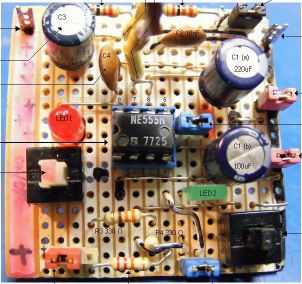
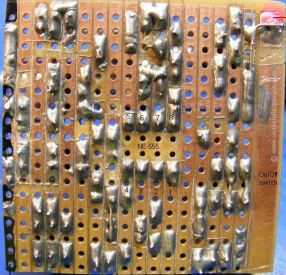
If you just want to build a circuit, see it work, then pull it apart, you can use a BREADBOARD.
This is one of the worst breadboards. It does not have any positive and negative rails:
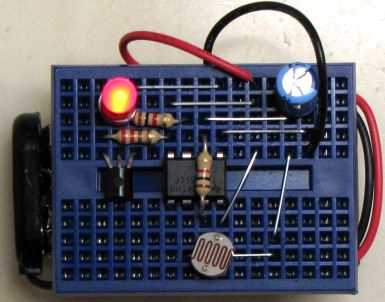
This is the best breadboard with TWO power rails. When the board is placed as shown, the positive and negative rails are close to the components. The only problem with this type of board is fitting components with thick leads such as power transistors, regulators, switches etc.
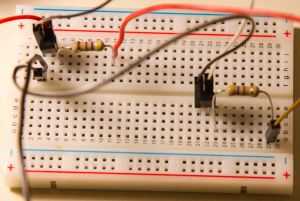
If you are designing 10 projects at the same time, you will quickly run out of breadboards.
They are also quite unsuitable for RF projects.
Breadboards also have a problem of wires touching and connections becoming noisy.
Also, the connections become loose after a thick lead has been inserted and thin pins do not touch the contacts. This especially applies to IC sockets where one or more of the pins will not make contact and you will spend hours trying to find the fault.
The solution is a PROTOTYPING BOARD
Here are some prototyping boards from Talking Electronics:
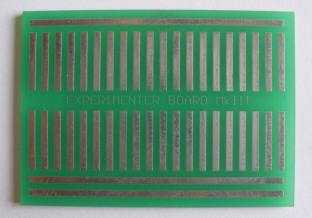
Surface Mount Board MkIII
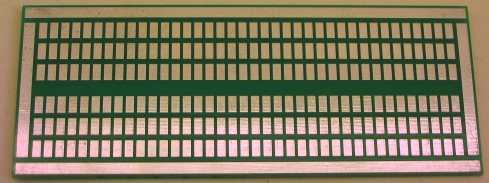
Surface Mount Board 15x40 SM-2 40mm x 105mm $2.50 each
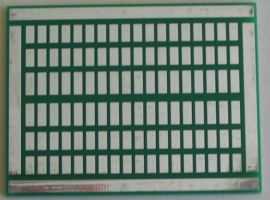
14 x 20 Surface Mount $2.50
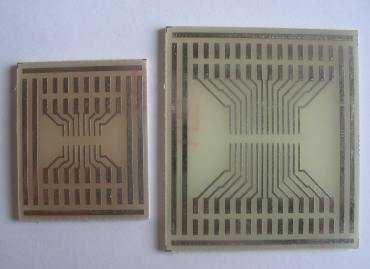
Two surface-mount boards from the range from Talking Electronics $2.50 each
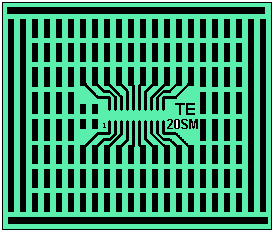
This board accepts a 20 pin Surface Mount chip $2.50
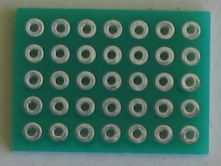
7 x 5 holes 50cents
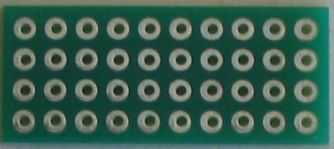
10 x 4 holes 50cents
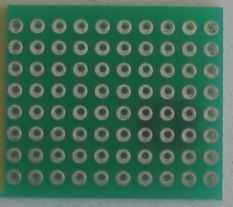
10 x 8 holes 50cents
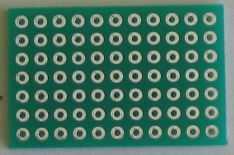
11 x 7 holes 50cents
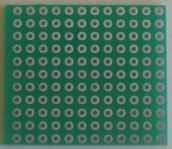
12 x 11 holes $1.00

9 x 19 holes $1.50
also:
15 x 12 $1.50
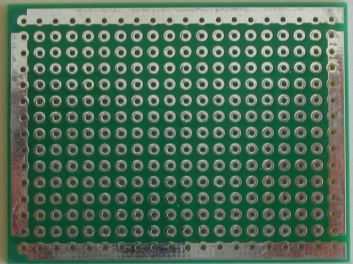
20 x 15 holes $2.50
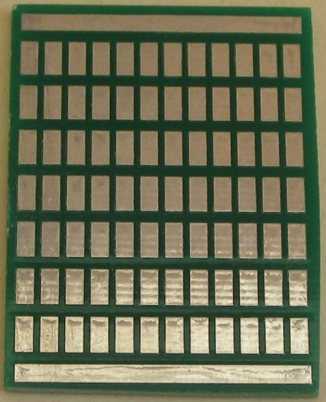
16 x 12 Surface Mount $2.50
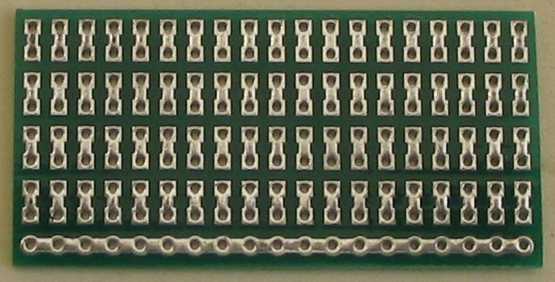
9 x 20 Surface Mount $2.50

11 x 38 holes (double-sided - PTH) $2.50

6 x 38 holes $1.50
also
6 x 40 holes $1.50
5 x 18 holes $1.00
5 x 23 holes $1.00
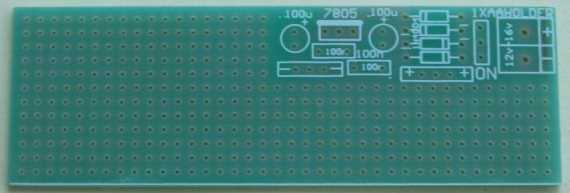
10cm x 3cm Matrix Board with POWER SUPPLY $2.50
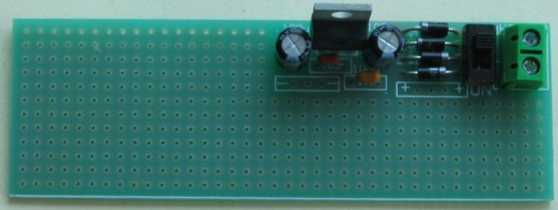
10cm x 3cm Matrix Board with POWER SUPPLY - built-up
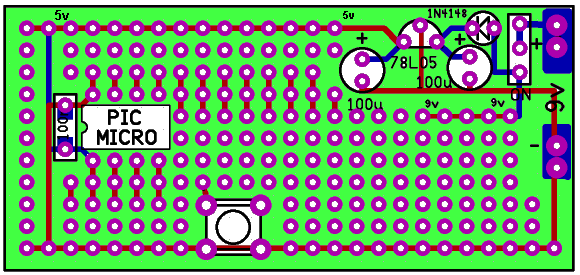
PIC Matrix Board with POWER SUPPLY $2.50
This board is specially designed for a PIC chip with the power rails to the chip already provided.
It is designed to allow you to produce a very fast, neat prototype.
There is a 5v rail from the regulator and a 9v rail from the battery.
The battery clips directly to the board or via a battery-snap.
Some prototyping boards are not designed to look beautiful. They are designed to be functional and reduce frustration.
A prototype project is sometimes called a “rats-nest” or “birds-nest.”
There are two levels of prototyping.
The first level requires no experimenting. It’s simply building a “proven” circuit on a board and connecting it to other items.
The second level involves experimenting and changing component values. For this, the components should be on one side of the board.
The end-result is a jumble but it’s the only way to be able to get-to-everything and see the whole circuit:
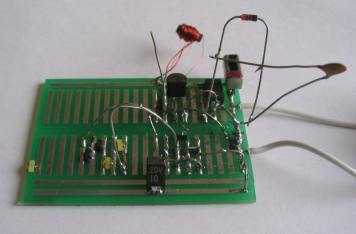
A surface-mount 5v2 power supply under development
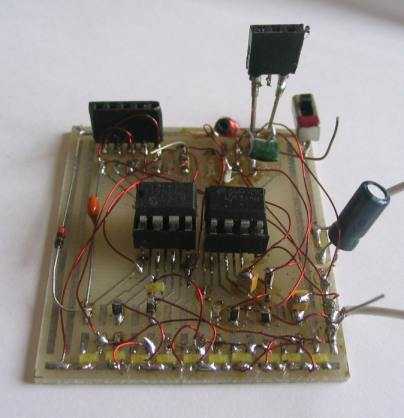
A PIC microcontroller and op-amp with 11 LEDs and surface-mount components
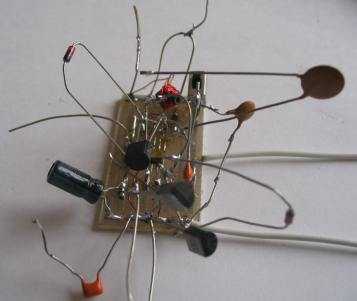
A very cluttered board
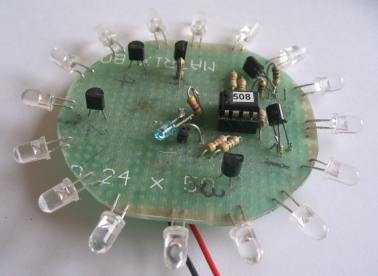
Rotating Beacon prototype, after the “rats-nest” design and before the final board
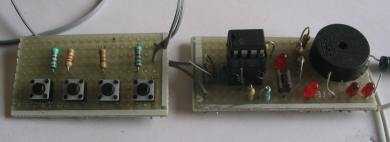
Using a Matrix Board for designing
Many prototyping boards on the market are quite useless. They are not really prototyping boards but rather “Universal Boards” that will accept different components and hand wiring.
The essential part of a prototyping board is the accessibility of each and every component so the voltage and waveforms can be measured.
But the most important reason is each component must be easily removed and/or replaced. That’s why soldering components through holes is not suitable. Sometimes a component has to be changed 4 or 5 times. Imagine the difficulty in pulling out a component every time you want to alter the value.
Some of our prototype boards have certainly become over-crowded but that’s how a circuit gets designed.
Initially you think the circuit will need a few components and choose a small PC board. It quickly gets over-crowded but as the circuit develops, you can easily see what each component is doing and it’s really not complex at all.
You will notice many of the circuits in the photos above have been designed with surface-mount components.
These are just as cheap as normal components and since they take up less space on the board, it creates less clutter and you can see what you are doing.
Surface-mount kits are available from Talking Electronics and when combined with the prototyping boards, you will be able to develop circuits that are very compact.
THE SECOND STEP
The second step before making a PC board is to lay out the components on a matrix board in the same locations as they will appear in the final design.
This will give you two answers. It will let you know if the project will work and give you some idea of the size of the board and where each item is positioned. The underside of the board is generally a mass of fine wiring and it may need one more layout to produce wiring that does not cross at any location. Any wires that cross each other need a jumper and by carefully re-laying the board, no jumpers will be needed. Here is our example of the PIC Lab-1 before the final PC layout. The stage before this was a “rats-nest” and the final design you can see in the PIC Lab-1 article.
If you think our projects “magically appear from no-where” you should see our boxes of thousands of prototypes!
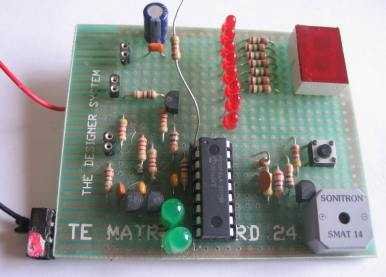
The second step to making a PC board
If you are thinking of going to the next step and designing a PC board for your project, here are a few tips:
DO NOT use PCB software associated with any PC manufacturer. You are LOCKED-IN to their costing and it is generally EXORBITANT.
Do not accept “touts” sending you emails from PCB manufacturers. These costings are also very high and generally the person behind the email is working from home as a “go-between.” They MARK-UP the prices from the manufacturer and you don’t get a bargain.
Here is a website that compares the cost of making a PCB from different manufacturers:
http://pcbshopper.com/
Many of the manufacturers are a RIP-OFF They quote $36.00 for 3 boards plus $15.00 delivery.
But the size of the board is 3cm x 3cm.
Who wants a board 3cm x 3cm ????
When you peel away all the SCAMs, there are only a few manufacturers who offer low prices.
The cheapest and best is: http://www.elecrow.com/
They produce 10 panels 10cm x 10cm double-sided green solder mask, PTH, HASL with white legend on top and bottom for $12.00 Plus $9.00 shipping.
The quality is perfect and you could not buy the materials for $12.00
The only problem with low-cost boards is the size. You have to keep the size smaller than 10cm x 10cm.
Any board over 10cm x 10cm costs 300% more and you will find this provides a very good learning-curve to producing modular systems with a maximum footprint of 10cm x 10cm.
You can stack the board on top of each other or provide plugs and sockets to join the edges.
This way you can produce an OUTPUT BOARD, POWER SUPPLY BOARD, display board and a number of INTERFACE BOARDS and create a whole range of different produces with a small number of modules.
SOFTWARE
If you really want the simplest software for designing a simple board, try this FREE software:
http://techdocs.altium.com/display/ALEG/Legacy+Downloads
Autotrax
DOS Freeware version 1.61 - Complete PCB layout package with output support for printers, pen plotters and Gerber.
To install: Download and run the file in the root directory of your hard drive to extract the install program. The install program must be run from the root directory.
Download (ZIP 821 KB)
EasyTrax
DOS Freeware version 2.06 - Complete PCB layout package with output support for printers, pen plotters and Gerber.
System requirements: PC-compatible; DOS 2.0 or later; 640K RAM; 2Mb of hard disk space.
Download (ZIP 485 KB)
You can contact me (Colin Mitchell) for a list of features on how to drive the software.
I have been using the same DOS software for 40 years because no software is compatible with other programs and when you want to make a panel of 15 different boards, they must all be developed from the same software.
Many free software packages only allow you to make a small board or a limited number of holes or you cannot export the file or some other frustration.
That’s why I keep using the simplest package: Autotrax.
Here are some replies from readers who have used different packages and found the pit-falls:
SoloPCB can be seen at
http://www.fabstream.com/solopcb-design-software.php
Designspark PCB: Requires a registration which is free but it’s bug-ridden and last time it didn’t work. Support couldn’t solve it. Later I realised it required constant connection to the net with cookies enabled.
It’s to hard to use. And the schematics it produces look terrible. The only thing I can see that it’s good for, is if you need to make a really big PCB. Because you can make a up to a 14 layer board, and it has no pad number restriction. Also, it has a 3D PCB function.
Diptrace: It’s the best EDA software I have ever used! It has a HUGE library of parts, and a really neat 3D PCB feature. And it’s super easy to use! It’s documented better then any EDA program I have ever seen.
Fritzing is a toy.
Kicad I found to be full of bugs to the extent of uselessness. I deleted it when I found myself fighting the software rather than designing a PCB.
It’s really easy to figure out, but it takes to long to do anything in it.
FreePCB wasn’t maintained for the last three years – since 2011. This tells the story.
All I remember about it is, I did not like it, and uninstalled it within two days of getting it (that’s most likely not very helpful).
OsmondCocoa (http://www.osmondpcb.com/index.html)
Unfortunately, you can only do PCBs in it. It’s really good if you have a Mac computer, and it’s also really easy to use.
TinyCad is what the name says: tiny. The library is extremely limited. For example there are only 11 microcontrollers.
ExpressPCB is anything but express. Very difficult to use it. If you re-position a part, you have to re-align every-single-connection going to it. This means, every corner of every line. This is perhaps the most cumbersome to use among all of these. Badly limited library.
ExpressPCB/ExpressSCH (http://expresspcb.com/ExpressPCBHtm/Free_cad_software.htm)
Really great program, easy to use, and it produces really nice schematics. Only thing I don’t like about it is, you can’t export boards to send to manufacturers other then ExpressPCB.
ZenitPCB (http://www.zenitpcb.com/)
I could never figure out how to use it. It looks like it would be very useful if it had better documentation.
LIST OF EDA SOFTWARE (ELECTRONICS DESIGN AUTOMATION)
** These packages include schematic “capture” and PCB layout. Some include autorouters. The commercial packages also include autorouters, simulation, and other features.
Web-based (run in browser):
| 123D Circuits | http://www.123dapp.com/circuits | - |
|---|---|---|
| Upverter | http://www.upverter.com | Free for publically visible designs |
| EasyEDA | http://easyeda.com | - |
Free and low-cost packages:
| AutoTRAX DEX 2020 | http://www.dex2020.com/ | Free trial; full price USD 49; not related to Protel Autotrax |
|---|---|---|
| DesignSpark PCB | http://www.rs-online.com/designspark/electronics/page/ designspark-pcb-home-page | Free (non-commercial and commercial); affiliated with RS Components. Anon: Requires (free) registration; buggy; requires constant internet connection with cookies enabled. Supercap2F: Too hard to use; schematics look terrible; supports large sizes and many layers; has 3D PCB view. |
| Eagle | http://www.cadsoftusa.com/ | Windows/Linux/Mac. Widely used. Free version has limitations. Can only do 90mm x 90mm board!! Quite useless as most PCB makers will make 100mm x 100mm for $10.00 |
| ExpressSCH, ExpressPCB | http://expresspcb.com | Windows only. Anon: Very difficult and cumbersome to use; moving a component requires manual realignment of all connections to it; very limited library. Supercap2F: Great program, easy to use, produces really nice schematics, but cannot export boards to send to manufacturers other than ExpressPCB. |
| FreePCB | http://www.freepcb.com/ | Anon: Not maintained since 2011. Supercap2F: I did not like it |
| Fritzing | http://fritzing.org/ | Schematics, PCBs, breadboard and stripboard layouts. Anon: “a toy”. |
| gEDA suite | http://www.geda-project.org/ | Posix/Linux; GPL |
| KiCAD | http://www.kicad-pcb.org/ | This has been referenced by Elektor to be the best free CAD program to make your own boards. Version 4.0.7 |
| PCB123 | http://www.sunstone.com/pcb-products/pcb123 | Windows only. They offer PCB manufacturing services |
| Protel Autotrax and EasyTrax | http://techdocs.altium.com/display/ALEG/ Freeware downloads | MS-DOS - use DOSBox (http://www.dosbox.com) under Windows |
| TinyCAD | http://sourceforge.net/projects/tinycad/ | For schematics (includes netlist export) and line diagrams. Anon: Library is extremely limited - there are only 11 microcontrollers. Good reviews on sourceforge. |
| ZenitPCB | http://www.zenitpcb.com/ | Supercap2F: Could be good if it had better documentation. |
Professional with free limited versions:
| Bartels AutoEngineer | http://www.bartels.de/bae/bae_en.htm | Windows, Linux, X11/Unix. Schematic is free; PCB has a free demo version But you may not be able to use the free version to make a PCB. Bartels AutoEngineer Light, the entry level system for double-sided PCBs up to euro format size (160 × 100 mm) is 159 Euro plus VAT and delivery. |
|---|---|---|
| Cadstar | http://www.zuken.com/en | Free version limited to 300 pads and 50 components |
| DipTrace | http://www.diptrace.com/ | Windows/Linux. Free version limited to 300 pads and 2 layers. KrisBlueNZ: Produces very nice-looking schematics. Supercap2F: Highly recommended. Huge parts library; 3D PCB view; very easy to use; very well documented. |
| OsmondCocoa | http://www.osmondpcb.com/index.html | Mac only. Free version limited to 700 pins. Supercap2F: PCB only. Very easy to use. |
| Target 3001 | http://ibfriedrich.com/ | Free version limited to 250 pads and 2 layers |
| VUTRAX | http://www.vutrax.co.uk/index.htm | - |
Professional without free or cheap versions:
| Altium | - | Formerly Protel |
| Boardmaker | http://www.tsien.info/ | 3D viewer. KrisBlueNZ: Looks expensive! |
| CIRCAD | http://www.holophase.com/index.html | - |
| EasyPC | http://www.numberone.com/ | Free version can’t save nor generate output |
| EDWinXP | http://www.visionics.a.se/ | Evaluation period is 14 days |
| Multisim | http://www.ni.com/multisim/ | Schematic capture and SPICE simulation; see Ultiboard |
| OrCAD | http://www.orcad.com/ | - |
| PADS | - | - |
| Proteus | www.labcenter.com/ | - |
| Pulsonix | http://www.pulsonix.com/ | - |
| Sprint-Layout | http://www.abacom-online.de/uk/html/sprint-layout.html | Inexpensive |
| Ultiboard | http://www.ni.com/ultiboard/ | PCB option for Multisim |
http://www.tsien.info/ (boardmaker)
http://www.ni.com/ultiboard/
http://www.abacom-online.de/uk/html/sprint-layout.html
http://www.cadcam-group.eu/electronics/software/p-cad/ (PCAD)
http://www.rimu.pl/hs/rimuuk.html (RIMU)
Some software will freeze-up and you will lose everything you have done. Other software cannot be saved as a file. Some software cannot be sent to any PCB manufacturer … it can only be sent to the expensive manufacturer that supplies the software.
Here is an interesting article from David L. Jones on the terminology you need to know when designing your own Printed Circuit Board:
PCB Design Tutorial
Gerberview websites:
http://sourceforge.net/projects/gerbv/http://www.easylogix.de/products_detail.php?prog_id=1
http://www.pentalogix.com/viewmate.php#main-content
Here is an interesting discussion on CAD programs:
Does anyone know of a Good Free EDA design package?
I have been looking for a good free EDA design package, I have looked at Design Spark ,Ki cad, and Easy EDA. Has anyone recommend a EDA package that has stable parts and components and that is easy to use. I’m not sure any decent EDA suite will have “stable parts and components”. That may suggest it is stagnant!
Answer from ANDY FIERMAN:
Of all the free EDA tools, I can recommend EasyEDA.
It is still in the earlier stages but is developing rapidly into a very capable EDA tool for schematic capture and PCB layout (up to about 6 layers).
It includes simulation too.
It has a lot of library parts but the single thing that makes it stand out is that it is easy to learn to drive.
That means that even if the part you need is not there already, it’s easy to create your own and that automatically gets shared with the whole library so the library builds up very quickly.
EasyEDA has several import options for Eagle, KiCad and LTspice files. It also has several export options (have a look at their Tutorial).
KiCad and gEDA are more powerful cross-platform tools but are quite hard to learn. Being FOSS, they have open file formats. Simulation is not well integrated with them.
Design Spark is developing well but I don’t know much about using it. I assume it has open file formats. It’s import and export look reasonably good.
expressPCB is another free tool but watch out for being tied into buying PCBs from them.
Even though EasyEDA offers a low cost PCB service, they don’t tie you into using it. Gerbers can be downloaded and sent to any PCB fab.
The thing I don’t like about being tied to a PCB vendor is that you do all the work and then you end up with nothing you can carry away with you.
And if you seriously want to do controlled impedance work then you must have the freedom to choose your PCB materials, stackup and maybe even fab house.
EasyEDA supports a single set of PCB track design rules but tracks can be modified on a per track basis so you can manual define tracks that you need to be specific widths.
For a defined impedance you will then have to specify a substrate material and – if it’s really important – a material manufacturer.
You will also have to specify the layer spacings. EasyEDA currently uses a default set of layer spacings and the material is uncontrolled. You can contact EasyEDA via their support email address to discuss your requirements or to find out what the default stackup and materials are and then design the trace widths to suit.
If that isn’t enough then you still have the option to specify what you want in the design in EasyEDA, generate and download the Gerbers at the end of the design and then take them to a PCB fab house than can make exactly what you want.
That’s the crucial bit that you can’t get with a tied-in free tool.
I don’t think any online tool (certainly not a free one, unless the free version of Upverter supports it?) allows you to define a trace impedance and then have it work out the required trace width for you on a given substrate and stackup.
KiCad has a trace impedance calculator built into it but that is not tied into any form of Design Rule definition or checking. There are many similar online trace impedance calculators that would give adequate trace dimensional information consistent with the degree of impedance control precision you might be able to achieve using EasyEDA.
It’s not until you get up to the higher end tools like Altium (maybe), Cadence and Mentor that you get true controlled impedance design capability. In tools like that you can specify the detailed layer stackup and then specify trace impedances in the schematic. Then they are passed through into PCB layout and actually define the trace dimensions.
All of that information is then used to run Signal Integrity simulations and, in some tools, RF and Microwave simulations.
That said, it is possible to create quite effective simulations of controlled impedance circuits in EasyEDA because the underlying spice engine supports a range of transmission line structures.
It’s fiddly to set up and again is not tied into the PCB design rules in any way: it just shows what the circuit would do if the PCB had all the right impedances in it. You still have to manually calculate all the PCB trace width and stack-up dimensions, taking into account the dielectric constant of the substrate material. That can be partially automated by building parameterised expressions into the simulation to incorporate those given substrate parameters. If you wanted to go into that much depth, I’m sure contacting support at EasyEDA would get you some further guidance on this.
50 Top Product Design and Product Development Software Tools
http://www.pannam.com/blog/best-product-design-software-tools/
The link above covers 50 CAD packages that allow you to produce a PCB from a circuit or from laying out the board yourself.
Remember, some of the FREE packages from PCB manufacturers only allow the board to be made by the company that has supplied the free software and they generally charge a lot more than the Chinese manufacturers.
In addition, you cannot get the artwork without paying a lot for it.
The free package ends up a lot more than using a package that is not tied to any manufacturer.
If you are just starting out, you need to use the simplest software because that is all you need and keep to the same package as you will need to import older boards when you make new panels.
The cheapest is to get 1, 2, 3, 4 or 5 boards on a panel 100mm x 100mm and cut them yourself with a hacksaw. Make sure the cut lines can be done with a saw. You can get 10 panels for $25.00 incl post from: http://www.elecrow.com/ without any complex forms on the web and without any tricks.
MORE NOTES ON MAKING YOUR OWN PC BOARDS
It’s wonderful to have a CAD package that creates a CIRCUIT BOARD from a schematic.
But there are a number of things you have to remember.
These types of packages has a lot of automatic or “controlled” features that make it difficult for you to “do your own thing.”
It’s only a completely manual package that gives you full control.
On top of this, some packages are very difficult and time-consuming to learn and things such as “reverse reading” of text may takes you hours to work-out.
The first thing to do is try a number of packages and make sure thy can be saved to a file and then sent to a manufacturer. Some packages can only be sent to one manufacturer and the cost will be very high.
When you are satisfied with a package, it will be the only one you use for ALL your boards.
It may not be possible to combine two programs and thus you will not be able to import old boards to your recent panels. So, stick to a single package.
Stick to dimensions up to 10cm x 10cm as this is the cheapest panel to get processed and if you are thinking of making boards larger than this, consider creating modules of 10cm x 10cm and plugging them together.
This will make manufacturing and servicing easier and cheaper.
When creating the layout, you need to place the major components on the layout in places where you want them. The program will then connect them via tracks. Always use a double-sided board as this is the cheapest option.
Always identify EVERY component on the board so you can build it without referring to any other list of materials.
Give every board a name, add your email address and date of manufacture, so anybody can contact you if a fault occurs.
When you have hundreds of boards, you will appreciate this. Customers email after 10 years and want a replacement.
Now we come to the technical side.
Don’t expect a project to work perfectly the first time.
You may need to add or move a component or add more text.
If these changes are major, re-name the board with a new serial number and make sure the old boards are placed in a sealed bag and destroyed when the new boards arrive.
When making changes, you will appreciate software that allows you to move any track or component without moving other tracks on the board.
Some software moves tracks “off the screen” and when you zoom out, the whole board is messed up.
You also need to be able to change the size of any track or pad to make modifications, so make sure the software can do this before deciding on the package you will use.
Always save your work after 10 changes so you can go back to a previous board if you make a mistake.
Use the simplest software package so you are in charge and able to make your own modifications without being limited to angles, widths, sizes etc.
If you get frustrated with a package, try another. There are over 30 packages on the web.
Once you enjoy making boards you will want to create something every few days.
I have been making boards for over 30 years and I am creating a new board every week.
I use the first CAD package to be invented PROTEL (Easy Trax version). It has NEVER fallen over, crashed or frozen-up. Unlike some of the other packages that run out of memory when you are trying to combine boards.
It is up to you to choose a package and stick with it and enjoy the reward of making your own boards.
It is not economical making one board at a time.
You can fit 5 small boards on a 10cm x 10cm panel and only get the outer edge routed. This will cost $25.00 posted for 12 panels.
Make sure you can cut the boards yourself with a hack saw and allow 70 thou between boards for cutting.
Linish the edges with sandpaper and you will have expertly made boards.
And finally, the most important tip of all.
As you get a collection of boards, you can use various parts of the previous boards to help create a new board.
This is a very good idea because you know the size and shape of the components is correct and things like switches and sockets will fit the board without any problems.
You also need a digital caliper to measure different components to make sure the spacing is correct.
All boards are measured and created in inches but the final boards have to fit in a 10cm x 10cm (3.93inches) panel. I know it is messy but digital calipers cost less than $25.00 and are useful in the workshop for measuring all sorts of things. They are especially useful when making components (for your own library) such as switches, to get the spacing correct.

Here is a set of notes and more references to additional PCB design packages:
http://www.electro-tech-online.com/threads/the-scoop-on-pcb-layout-software.111236/
(copy and past if this link does not work inside this frame)
There are some manufacturers that combine your boards with those of others and charge by the square inch.
You have to do your own research before starting - to find out which is the cheapest and best for your situation.
In the end you will get great satisfaction in creating a compact board from a very complex design.
MORE
Here’s a list of 14 FREE CAD packages from:
http://www.edn.com/electronics-blogs/all-aboard-/4441802/3/Free-PCB-ECAD—The-Ultimate-list
The website shows some amazing things you can create with these packages.
These designs take years of experience to master.
Just start with simple boards and get the satisfaction of seeing your ideas come to life.
Work up gradually and make sure you use a package that does not make you frustrated.
Making PC boards is one of the best things you can do. It is so rewarding.
PCB DESIGN SOFTWARE
https://www.electroschematics.com/2249/pcb-design-software/
Do you need a free PCB design software or tool to put in practice the new electronic project you’ve just designed? So, we present you 10 of the best PCB software tools available on the internet that will help you to develop your printed circuit board faster and with ease.
0 PCBWeb Designer
PCBWeb is a free CAD application for designing and manufacturing electronics hardware. Design multi-sheet schematics with our fast and easy-to-use wiring tool. Route multi-layer boards with support for copper pours and DRC checking. Integrated Digi-Key Parts Catalog with Bill of Materials Manager.
1 ZenitPCB
Is an excellent pcb layout design software tool to create professional printed circuit board ( PCB ). It is a flexible easy to use CAD program, which allow you to realize your projects in a short time. With ZenitPCB Layout is possible to create the project starting both from the schematic capture or by the layout itself.
2 TinyCAD
Is a program to help you draw circuit diagrams. It comes complete with symbol libraries to get you started straight away. As well as being able to simply print your designs, you can use TinyCAD to publish your drawings by copying and pasting into a Word document or saving as a PNG bitmap for the web.
3 Osmond PCB
Is a flexible tool for designing printed circuit boards. It runs on Macintosh. Its many features include: virtually unlimited board sizes, number of board layers, number of parts, support for both through-hole and surface mount parts and more.
4 BSch3V
Is a schematic capture program for Windows. The name “BSch” is an abbreviation of “Basic Schematic”. It has only basic functions, in order to simplify operation.
5 ExpressPCB
Is a snap to learn and use. Laying out PCBs is easy, even for the first time user.
6 Kicad
Is an open source (GPL) software for the creation of electronic schematic diagrams and printed circuit board artwork. It is useful for everybody working in electronic design (schematic diagrams and Printed Board up to 16 layers).
7 gEDA
Runs on Linux and has produced tools which are used for electrical circuit design, schematic capture, simulation, prototyping, and production. Currently, the gEDA project offers a mature suite of free software applications for electronics design, including schematic capture, attribute management, bill of materials (BOM) generation, netlisting into over 20 netlist formats, analog and digital simulation, and printed circuit board (PCB) design layout.
8 Fritzing
Fritzing software is an interesting open-source initiative to support designers, artists, researchers and hobbyists to work creatively with interactive electronics and develop electronic projects. Fritzing helps you learn more about electronic circuits, to document your projects and even let’s you prepare them for production.
9 DesignSpark PCB
DesignSpark PCB is the world’s most accessible electronics design software. Easy to easy to learn and easy to use, it is designed to significantly reduce your concept-to-production time. At the core of this unique approach is a powerful software engine that enables you to capture Schematics, design PCB boards and layouts.
10 EasyEDA
EasyEDA is a free, zero-install, Web and cloud-based EDA tool suite, integrating powerful schematic capture, mixed-mode circuit simulation and PCB layout in a seamless cross-platform browser environment, for electronic engineers, educators, students and hobbyists.
HOW A PCB IS MADE
These are the steps to make a PCB:
1 PPE - Pre Production Engineering
Customer supplied data (gerber) is used to produce the manufacturing data for the specific PCB (artworks for imaging processes and drill data for drilling programs). Engineers compare demands/specifications against capabilities to ensure compliance and also determine the process steps and associated checks.
2 Preparing the phototools
Artwork Master is PCB production in the key steps, which directly affect the quality of the final product quality. An accurately scaled configuration of electronic data used to produce the artwork master or production master. Artwork Master – The photographic image of the PCB pattern on film used to produce the circuit board, usually on a 1:1 scale. In general, there are three types of Artwork Master: (1) Conductive Pattern (2) solder mask (3) Silkscreen.
3 Print inner layers
Stage 1 is to transfer the image using an artwork film to the board surface, using photosensitive dry-film and UV light, which will polymerise the dry film exposed by the artwork. This step of the process is performed in a clean room. Imaging – The process of transferring electronic data to the photo-plotter, which in turn uses light to transfer a negative image circuitry pattern onto the panel or film.
4 Etch inner layers
Stage 2 is to remove the unwanted copper from the panel using etching. Once this copper has been removed, the remaining dry film is then removed leaving behind the copper circuitry that matches the design. Etching – The chemical, or chemical and electrolytic, removal of unwanted portions of conductive or resistive material.
5 Inner layer Automatic Optical Inspection (AOI)
Inspection of the circuitry against digital “images” to verify that the circuitry matches the design and that it is free from defects. Achieved through scanning of the board and then trained inspectors will verify any anomalies that the scanning process has highlighted.
6 Lay-up and bond (Lamination)
The inner layers have an oxide layer applied and then “stacked” together with pre-preg providing insulation between layers and copper foil is added to the top and bottom of the stack. The lamination process consists of placing the internal layers under extreme temperature (375 degrees Fahrenheit) and pressure (275 to 400 psi) while laminating with a photosensitive dry resist. The PCB is allowed to cure at a high temperature, the pressure is slowly released and then the material is slowly cooled.
7 Drilling the PCB
We now have to drill the holes that will subsequently create electrical connections within the multilayer PCB. This is a mechanical drilling process that must be optimised so that we can achieve registration to all of the the inner layer connections. The panels can be stacked at this process. The drilling can also be done by a laser drill.
8 Electroless copper deposition
The first step in the plating process is the chemical deposition of a very thin layer of copper on the hole walls. PTH provides a very thin deposit of copper that covers the hole wall and the complete panel. A complex chemical process that must be strictly controlled to allow a reliable deposit of copper to be plated even onto the non-metallic hole wall. Whilst not a sufficient amount of copper on its own, we now have electrical continuity between layers and through the holes. Panel plating follows on from PTH to provide a thicker deposit of copper on top of the PTH deposit – typically 5 to 8 um. The combination is used to optimise the amount of copper that is to be plated and etched in order to achieve the track and gap demands.
9 Image the outer layers
Similar to the inner layer process (image transfer using photosensitive dry film, exposure to UV light and etching), but with one main difference – we will remove the dry film where we want to keep the copper/define circuitry – so we can plate additional copper later in the process. This step of the process is performed in a clean room.
10 Plating
Second electrolytic plating stage, where the additional plating is deposited in areas without dry film (circuitry). Once the copper has been plated, tin is applied to protect the plated copper.
11 Etch outer layer
This is normally a three step process. The first step is to remove the blue dry film. The second step is to etch away the exposed/unwanted copper whilst the tin deposit acts an etch resist protecting the copper we need. The third and final step is to chemically remove the tin deposit leaving the circuitry.
12 Outer layer AOI
Just like with inner layer AOI the imaged and etched panel is scanned to make sure that the circuitry meets design and that it is free from defects.
13 Soldermask
Soldermask ink is applied over the whole PCB surface. Using artworks and UV light we expose certain areas to the UV and those areas not exposed are removed during the chemical development process – typically the areas which are to be used as solderable surfaces. The remaining soldermask is then fully cured making it a resilient finish. This step of the process is performed in a clean room.
14 Surface finish
Various finishes are then applied to the exposed copper areas. This is to enable protection of the surface and good solderability. The various finishes can include Electroless Nickel Immersion Gold, HASL, Immersion Silver etc. Thicknesses and solderability tests are always carried out.
15 Profile
This is the process of cutting the manufacturing panels into specific sizes and shapes based upon the customer design as defined within the gerber data. There are 3 main options available when providing the array or selling panel – scoring, routing or punching. All dimensions are measured against the customer supplied drawing to ensure the panel is dimensionally correct.
16 Electrical test
Used for checking the integrity of the tracks and the through hole interconnections – checking to ensure there are no open circuits or no short circuits on the finished board. There are two test methods, flying probe for smaller volumes and fixture based for volumes. We electrically test every multilayer PCB against the original board data. Using a flying probe tester we check each net to ensure that it is complete (no open circuits) and does not short to any other net. Good products come from good manufacturing but not inspection.
17 Final inspection
In the last step of the process a team of sharp-eyed inspectors give each PCB a final careful check-over. Visual checking the PCB against acceptance criteria. Using manual visual inspection and AVI – compares PCB to gerber and has a faster checking speed that human eyes, but still requires human verification. All orders are also subjected to a full inspection including dimensional, solderability, etc.
18 Packaging
Boards are wrapped using materials that comply with packaging demands (ESD etcetera) and then boxed prior to be being shipped using the requested mode of transport.
Email: jonny@apollopcb.com
Web: www.apollopcb.com
Page 2 Matrix Boards
Quick Links
Legal Stuff
Social Media


